The Eurasian blue tit is one of the most recognizable birds in the tit family, Paridae. This small passerine bird boasts bright shades of blue, green, and yellow. These bright colors make this attractive bird a favorite among garden visitors in Europe.
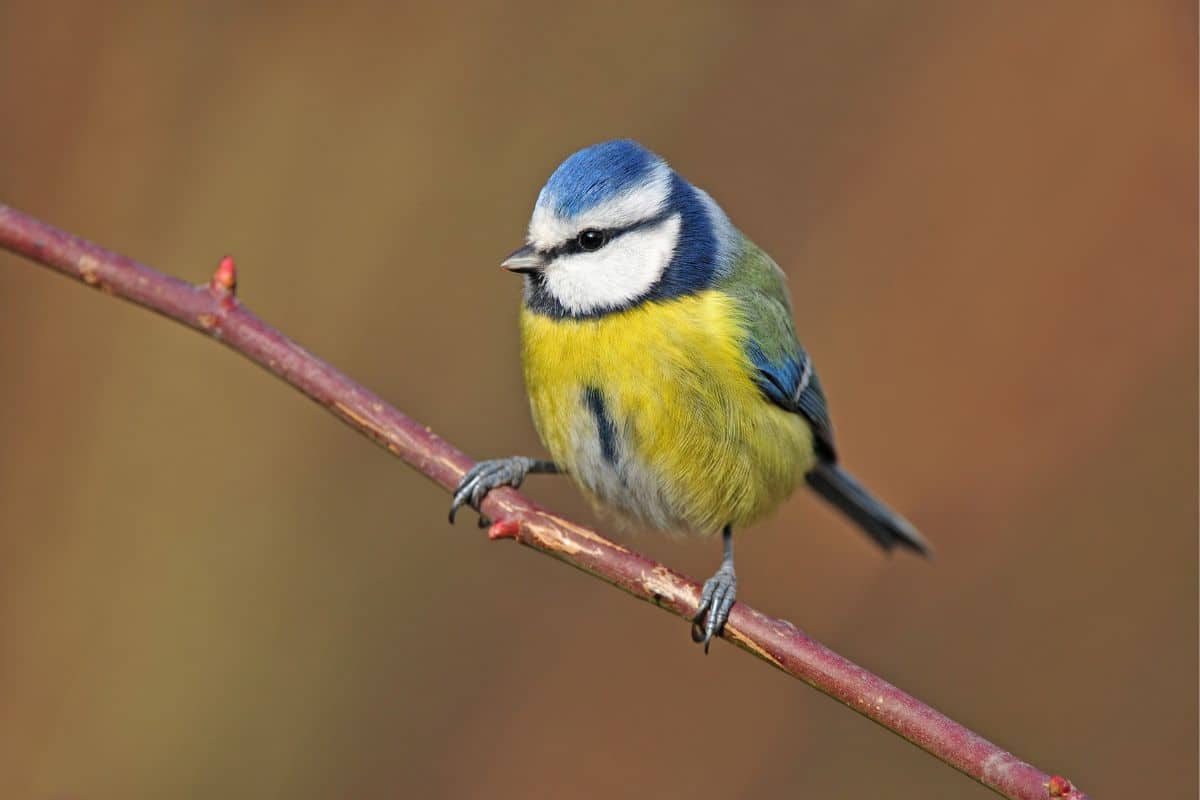
Eurasian blue tits are widespread throughout subarctic and temperate Europe and the Palearctic. Deciduous and mixed woodlands are their habitat of choice, nesting in a high proportion of oak. They will nest in nesting boxes but prefer to nest in the holes of trees.
When they are young, a Eurasian blue tit tends to be more yellow. As it grows older, the plumage develops the deep blue color we have grown to love today. These birds are a favorite among bird watchers throughout Europe.
Check out the following interesting facts and descriptions about the Eurasian blue tit. The ultimate guide will allow you to know all the facts about the Eurasian blue tit.
| Classification | Measurements | ||
| Scientific name | Cyanistes caeruleus | Length | 12cm |
| Other names | Eurasian Blue Tit | Wingspan | 18cm |
| Family | Paridae | Weight | 11g |
| Conservation status | Least concern |
Contents
| Average lifespan | 3 years |
| When to see | January |
| Where to see | In gardens and woodlands across Europe and Asia. |
Blue Tit Lifespan
Many factors determine how long a Eurasian blue tit will live. The environment they live in, the types of predators near them, diseases, and the food sources available. With so many factors, the Eurasian blue tit can have a range of lifespans.
On average, the Eurasian blue tit lives three years. Compared to other birds, this is a short lifespan. With so much variety in the term birds, there is a wide range of bird lifespans. The lifespan of birds is between four and 100 years because of the many species.
The oldest known Eurasian blue tit lived to be 11 years old. This Eurasian blue tit was in the Czech Republic, living almost four times the average lifespan of the species.
The lifespan of a Eurasian blue tit in your area depends on the habitat in your area.
Blue Tit Sound
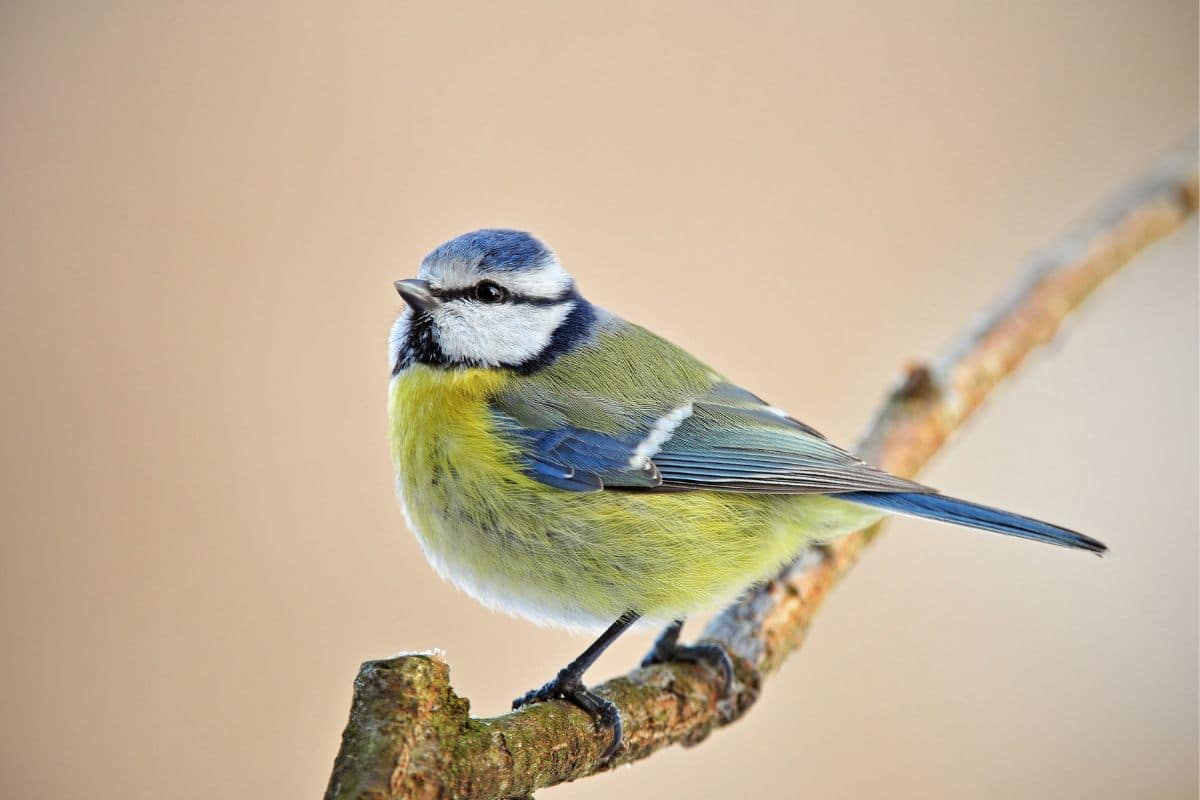
One of the best ways to distinguish bird species is by their song. There are many reasons birds sing. Birds can sing at any time, but it is most common from late winter to early summer.
Birds sing for multiple reasons. Birds sing for mating, trying to attract a mate to reproduce. They also sing as an effort to claim territory and strengthen pair bonds. We benefit from their beautiful songs, too!
Eurasian blue tits have a high-pitched tremolo, which ends in a trill. Male Eurasian bluetits can sing at any time of the year but are often heard from late winter to early summer. Female Eurasian blue tits sing, as well.
Male and female Eurasian blue tits sing for mating, a scolding call to defend food or protect their chicks. Their defensive call is different from their mating call because it scares things off, doesn’t attract them.
Blue Tit Behavior
Eurasian blue tits are family birds. While the mother is in the nest caring for the eggs, the father will be in and out of the nest bringing her food. The father continues this feeding technique even after the chicks have hatched.
While the mother is brooding, she will pluck her feathers to build a warm nest for the eggs. Like most animals, the mother sacrifices her warmth and comfort to care for her babies. She plucks her feathers, creating a bald spot called the brood spot. This brood spot allows direct contact with the mother’s warm skin and the eggs.
When they are not caring for their young, Eurasian bluetits are actively looking for food. They jump from the branches of woodland trees looking for spiders and insects. These active birds make a great addition to any beautiful garden.
Blue Tit Female
Male and female Eurasian blue tits have similar plumage and markings. They both have bright blue, yellow, and green feathers. It is difficult to tell a male from a female blue tit from physical appearances.
While females are still colorful, they are duller than a male blue tit. The male Eurasian blue tit has a more pronounced neckband that runs from the corner of the eyes and down the neck.
Because of these slight differences, it is difficult to tell if a single Eurasian blue tit is male or female. When there is both a male and female present, you may be able to spot the slight differences.
Male and female Eurasian blue tits have some behavioral differences. April is the breeding season for blue tits, making their behaviors the most different. A female Eurasian blue tit is working on her nest, while the male becomes territorial and often fights with other males nearby.
Blue Tits Eggs
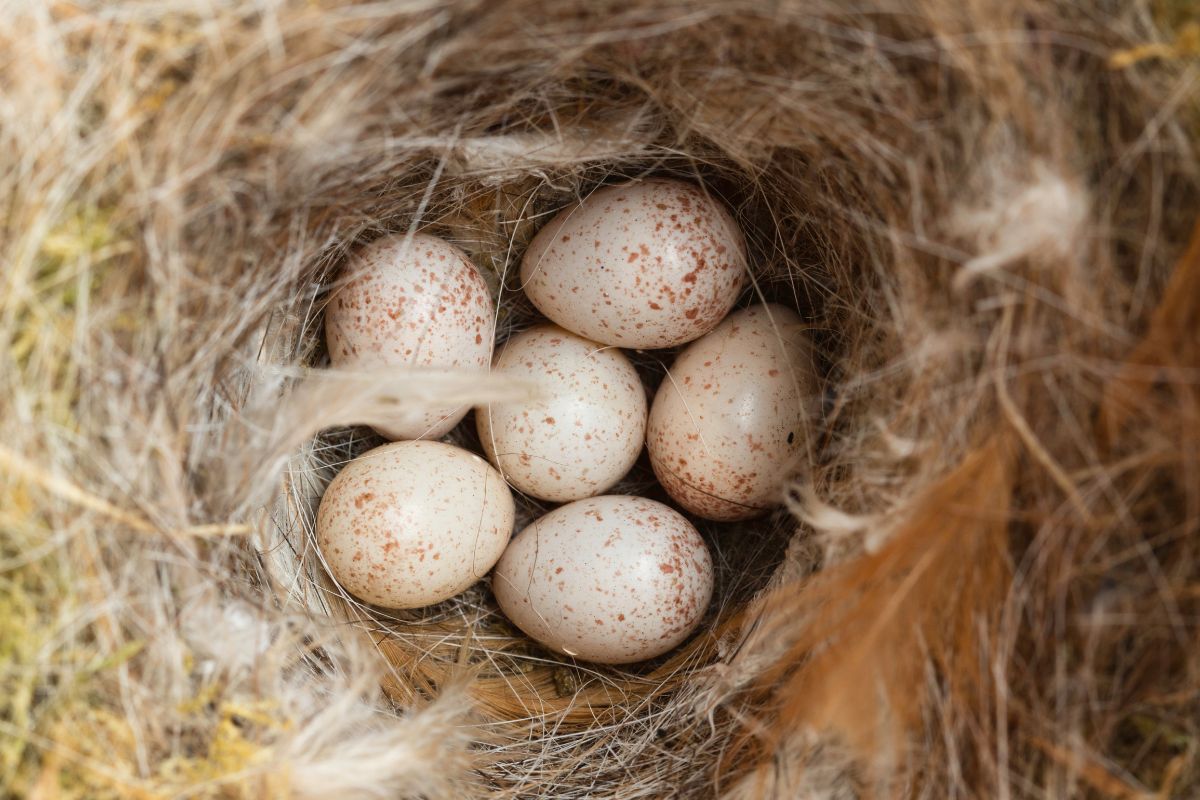
Reproduction is the main goal of all living things. If there is no reproduction, the species will be extinct. Birds must spend most of their life reproducing because their eggs are often used as a food source for local predators.
A female blue tit will lay eight to ten eggs in an average clutch. Eurasian blue tits are small birds, which makes the egg weight exceed the female’s body weight. The mother Eurasian blue tit incubates the eggs for thirteen to fifteen days before they hatch.
During the incubation period, the male Eurasian blue tit will bring food back to the nest to feed the mother blue tit. She does leave the nest occasionally but is mostly sitting on the eggs keeping them warm during the incubation period.
After the eggs hatch, the parents have a lot of work to do. They work from dawn to dusk finding food for their young. After three weeks, the chicks will start to fledge the nest and begin their own lives of reproducing.
Blue Tits Diet
Eurasian blue tits are very active feeders. The abundance of insects and spiders in your garden attracts them from afar. You will always see a Eurasian blue tit flying around jumping from branch to brand looking for its next meal.
While blue tits love insects and spiders, they will eat about anything. They are huge fans of caterpillars, feeding them to their young. Eurasian blue tit chicks have a diet of almost exclusively winter moth caterpillars.
Along with insects and caterpillars, Eurasian blue tits will eat seeds and nuts. Any quality bird feed should attract them. If you have trees around, you may not need birdseed because Eurasian bluetits are great scavengers.
During the winter months, blue tits will seek out dried nuts, seeds, and berries that have survived. They will try to find any surviving insects but tend to have more of a vegetarian diet during the colder months.
Blue Tits Color
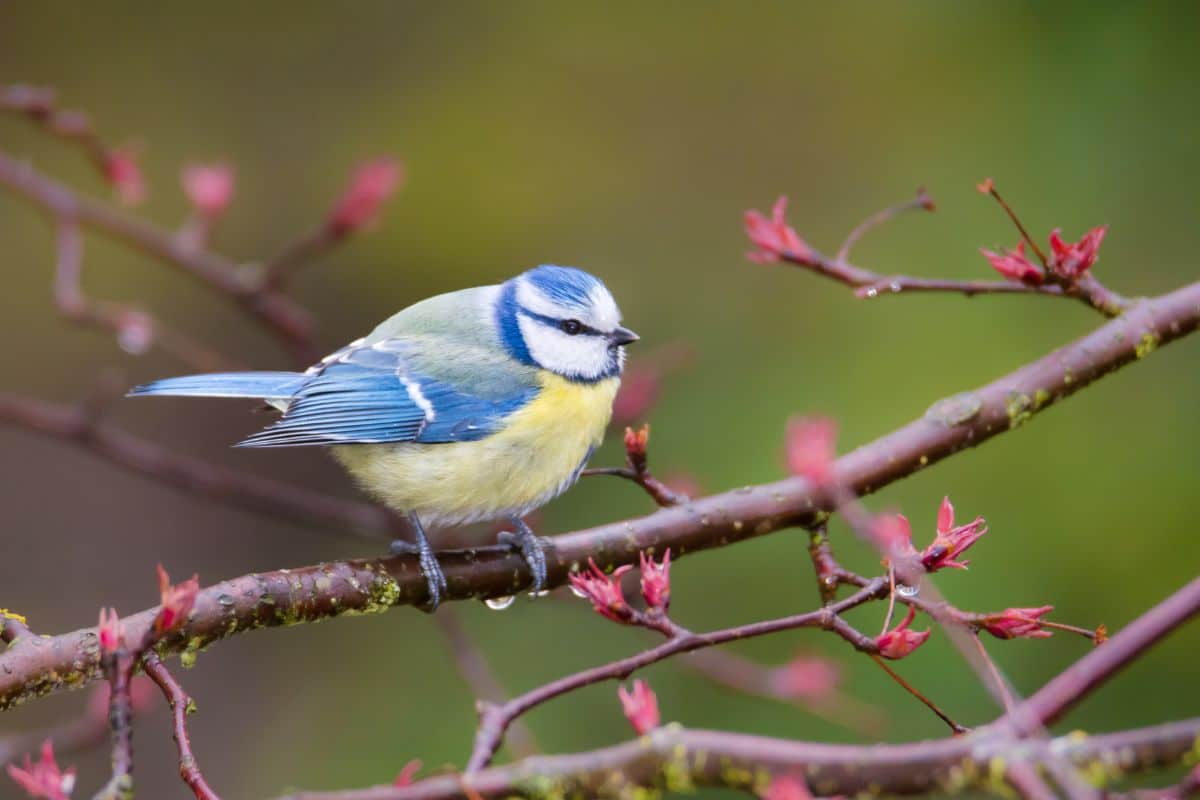
The appearance of the Eurasian blue tit is its most recognizable factor. They are a distinct, striking blue color with yellow breasts and hints of green in their rear plumage. They have white faces with black markings.
The male blue tit has more vivid colors than the female. The female is still brightly colored, but the male uses its striking colors as an attractant during mating season. Their bright colors make them stand out.
An interesting study found that plumage color changes at different times of the year. During the mating season in spring, the male plumage becomes a more vivid color after molting. This change in color increases the chances of mating.
Other birds in the tit family have a similar look to the blue tit, but differing coloration. Great tits are yellow and green with striking black heads. A crested tit has a black and white head with a creamy white and black body.
Do Blue Tits Migrate
Many species of birds migrate before the cold winter months hit. Most birds cannot handle harsh winters, so they migrate to a warmer climate for the winter. Some birds can handle the climate and stay close to their home year-round.
Eurasian bluetits tend to stay within 12 miles of their nesting areas each year. They prefer to stay close to home and not migrate to great lengths. Some will migrate a few miles, but most bluetits never leave the environment in which they hatched.
Blue tit migratory patterns depend on the personality of the individual. Just like people, some birds are born more curious and some are born a homebody. If a blue tit is curious, it will leave the area in which it was hatched. Even though it thinks it’s exploring far and wide, it still will not leave the greater area in which it hatched.
Where Do Blue Tits Live
Eurasian bluetits are residents of Europe and western Asia. The temperate climate of Europe and western Asia is perfect for the blue tits to live in. Because it stays mild, the Eurasian blue tit does not have to migrate for winter.
You can find Eurasian blue tits in gardens and wooded forests in Europe and western Asia. They love to be in the trees in parks, gardens, farmland, and hedges. They feel safe within the branches and build their nests there.
Blue tits love to forage through wooded areas for insects, spiders, and caterpillars for food. They eat nuts, seeds, and berries that they find in wooded areas. These wooded areas are perfect for mating, and raising young, and have plenty of food.
What Does a Eurasian Blue Tit Look Like?
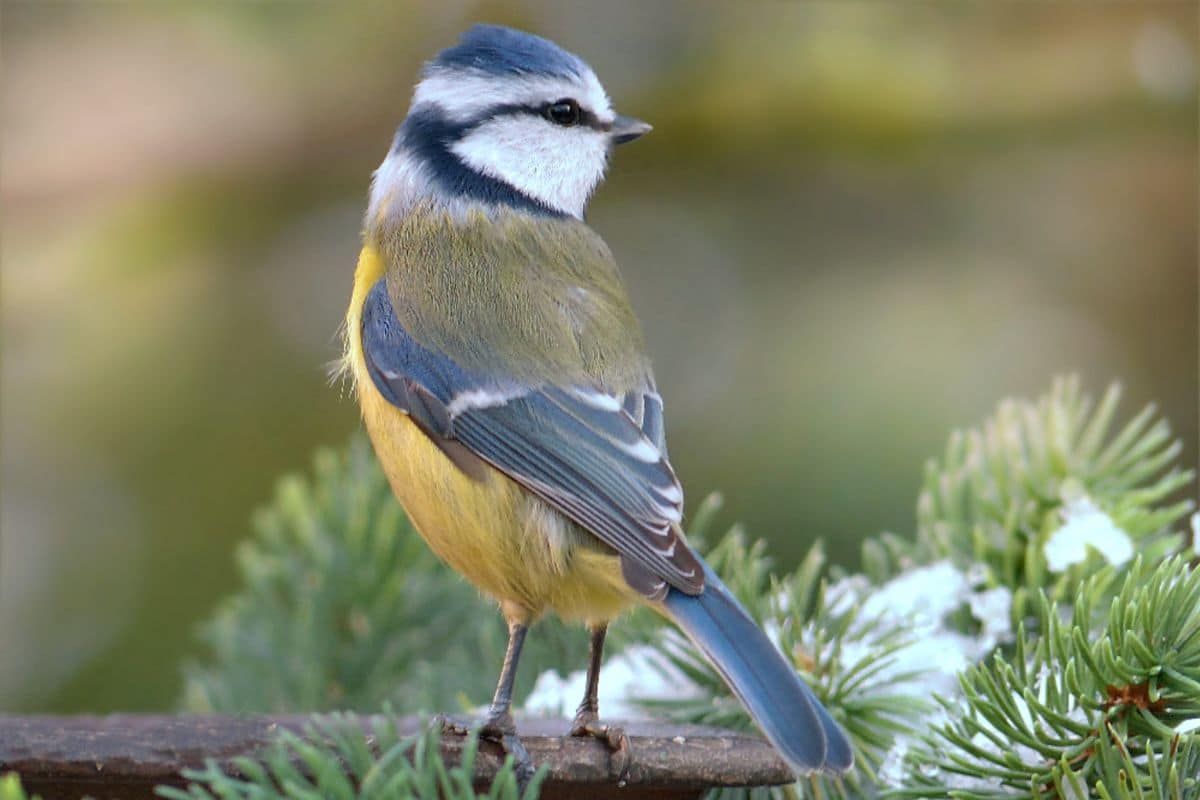
Eurasian bluetits are small birds. They are twelve centimeters long and have a wingspan of eighteen centimeters. The average blue tit weighs around 11 grams. They are fast flyers and can be spotted from far away because of their distinct colors.
Their striking blue will be the first to catch your eye. They are blue with yellow, white, green, and black on them. Their breasts are a bright yellow, with green on their rear plumage. Black markings give them a striking look.
They have smooth heads and black beaks and black eyes. Their thin legs are black and are used to hop from branch to branch while scavenging for food.
Final Thoughts
Eurasian blue tits are energetic birds that are irreplaceable. If you have a garden in Europe or western Asia, you are likely to see these cute little birds making it their home.
